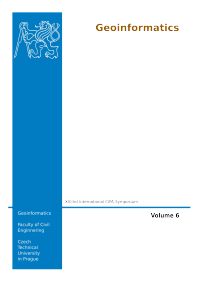Information Management Systems for Cultural Heritage and Conservation of World Heritage Sites. The Silk Roads Case Study
DOI:
https://doi.org/10.14311/gi.6.45Keywords:
documentation, world heritage, information management systems, serial nomination.Abstract
This paper discusses the application of Information Management Systems (IMS) in cultural heritage. IMS offer a set of tools for understanding, inventorying and documenting national, regional and World Heritage properties. Information Management Systems can assist State Parties, stakeholders and heritage site managers involved in cultural heritage management and conservation by easily mining, sharing and exchanging information from multiple sources based on international standards. Moreover, they aim to record, manage, visualize, analyze and disseminate heritage information. In close collaboration with five Central Asian countries, namely, Turkmenistan, Kazakhstan, Kyrgyzstan, Uzbekistan and Tajikistan; a Belgian consortium headed by the Raymond Lemaire International Centre for Conservation (RLICC), K.U.Leuven is developing the Silk Roads Cultural Heritage Resource Information System (CHRIS). This Web-based Information Management System supports the preparation of the Central Asia Silk Roads serial and transnational nominations on the UNESCO World Heritage list. The project has been set up thanks to the financial support of the Belgian Federal Science Policy Office (BELSPO) and in collaboration with UNESCO World Heritage Centre in conjunction with the People’s Republic of China and the Japanese Funds-in-Trust UNESCO project. It provides a holistic approach for the recording, documenta tion, protection and monitoring tasks as part of the management of these potential World Heritage Properties. The Silk Roads CHRIS is easily accessible to the general user, presented in a bilingual English and Russian frame and interoperable, i.e. open for other applications to connect to. In this way, all information for the nomination dossiers is easily verified regarding consistency and quality and ready for managing, periodic reporting and monitoring processes in the respect to the property listed. Fina lly, this study provides a general framework to establish the effectiveness and limits of the use of information systems for serial transnational nominations of World Heritage Properties and to demonstrate the potentials of an improved heritage documentation system.References
UNESCO, Operational Guidelines for the Implementation of the World Heritage Convention. UN Doc WHC. 08/01 January 2008. 2008.
UNESCO World Heritage Centre, World Heritage Centre - World Heritage List. [Online]. Available: http://whc.unesco.org/en/list. [Accessed: 11-Mar-2011].
IUCN, Engels B., Koch P., and Badman T., Serial natural World Heritage properties. An initial analysis of the serial natural properties on the World Heritage List IUCN .
B. Engels, Serial Natural Heritage Sites: A Model to Enhance Diversity of World Heritage?, in World Heritage and Cultural Diversity, vol. 4, Cottbus: German Commission for UNESCO, 2010, pp. 79-84.
Swiss Federal Office of Culture, O. Martin, and S. Gendre, Eds., UNESCO World Heritage: Serial Properties and Nominations. Swiss Federal Office of Culture, 2010.
Magin C., World Heritage Thematic Study for Central Asia a Regional Overview. 2005.
Jing F., UNESCO’s efforts in identifying the world heritage significance of the Silk Road, in Proceedings of the ICOMOS 15th General Assembly and Scientific Symposium. Xi’an, 2005, vol. 2, pp. 934-944.
Fodde E., Conserving sites on the Central Asian Silk Roads: the case of Otrar Tobe, Kazakhstan, Conservation and management of archaeological sites, vol. 8, no. 2, p. 77, 2006.
Fodde E., Conservation and conflict in the Central Asian Silk Roads. Journal of architectural conservation, vol. 16, no. 1, p. 75, 2010.
UNESCO, Guidelines for the Preparation of Serial Nominations to the World Heritage List. n.d.
Cleere H., Denyer S., and Petzet M., The World heritage list : filling the gaps, an action plan for the future. Paris: ICOMOS, 2005.
RLICC, Precomos - Preventive Conservation, Maintenance and Monitoring of Monuments and Sites [Online]. Available: http://precomos.org/index.php/member/login/. [Accessed: 07-Jun-2011].
van Ruymbeke M., Tigny V., De Badts E., Garcia-Moreno R., and Billen R., Development and use of a 4D GIS to support the conservation of the Calakmul site (Mexico, World Heritage Programme), in Proceedings of the 14th International Conference on Virtual Systems and Multimedia, Limassol, Cyprus, 2008.
ICOMOS, ICOMOS Charter- Principles for the Analysis, Conservation and Structural Restoration of Architectural Heritage. ICOMOS, 2003.
Letellier R., Ed., Recording, Documentation, and Information Management for the Conservation of Heritage Places, The Getty Conservation Institute. Los Angeles: J. Paul Getty Trust, 2007.
Downloads
Published
Issue
Section
License
- Authors retain copyright and grant the journal right of first publication with the work simultaneously licensed under a Creative Commons Attribution License that allows others to share the work with an acknowledgement of the work's authorship and initial publication in this journal.
- Authors are able to enter into separate, additional contractual arrangements for the non-exclusive distribution of the journal's published version of the work (e.g., post it to an institutional repository or publish it in a book), with an acknowledgement of its initial publication in this journal.
- Authors are permitted and encouraged to post their work online (e.g., in institutional repositories or on their website) prior to and during the submission process, as it can lead to productive exchanges, as well as earlier and greater citation of published work (See The Effect of Open Access).

